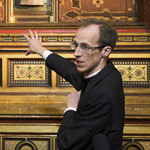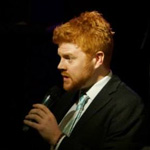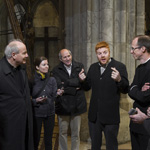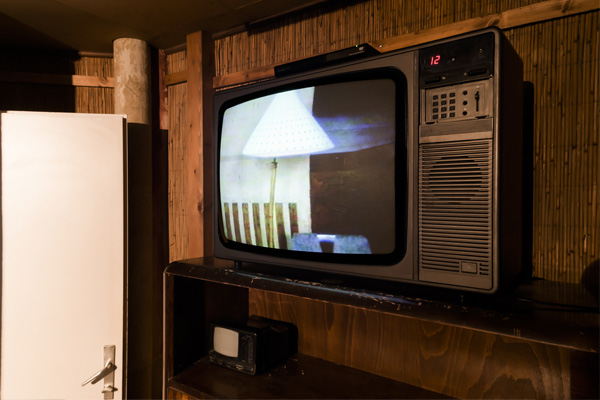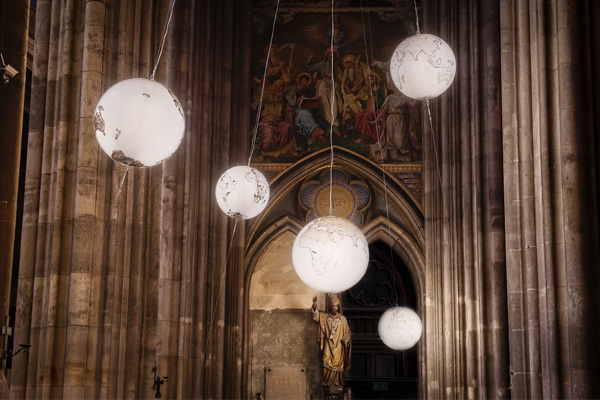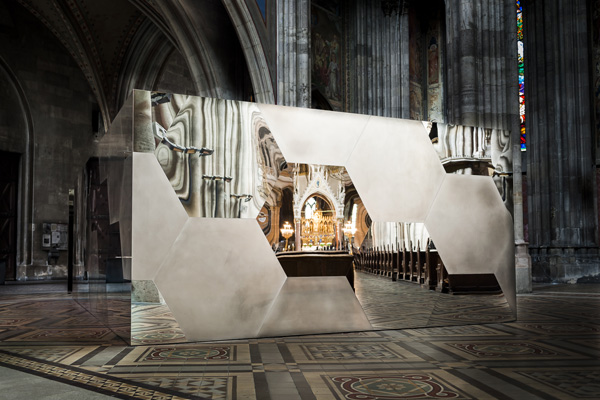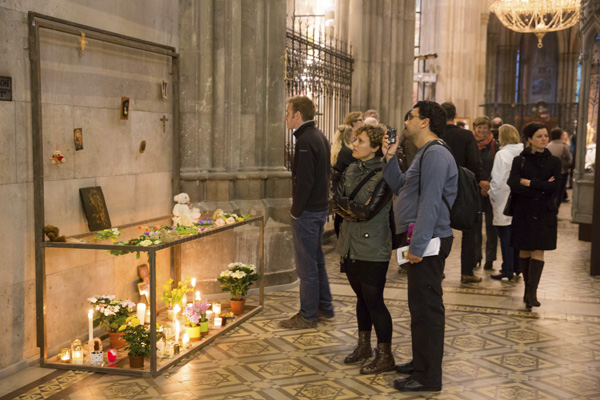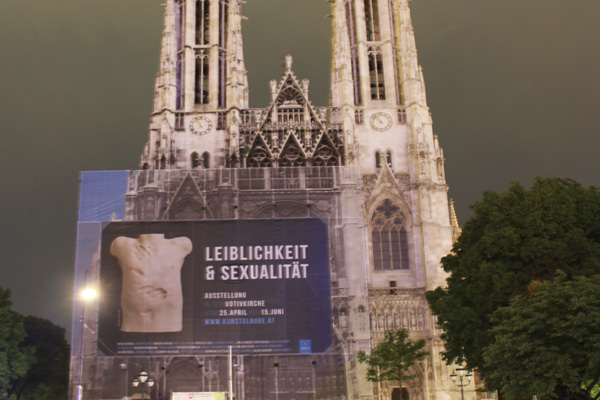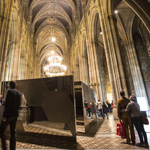WHY INSTALL CONTEMPORARY ART IN SACRED SPACES
We seek to prevent Churches from becoming 'monuments to the past' through re-activating sacred space with art reflecting the historico-cultural situation and circumstances of the present day. Sacred spaces have a long tradition of incorporating art of every age and epoch into their architecture and ritual space. The maintaining of this tradition is considered by KUNSTGLAUBE to be of utmost importance. If this tradition is not maintained, and our generation merely dusts and preserves the art from previous generations, there can be an implicit suggestion that religious mystery can only be revealed through art of the past.
WHY CONTEMPORARY ART?
Contemporary art (art since 1990) offers the possibility of an endless multiplicity of interpretation which had previously been unknown in art. It is unlike modern art which is best viewed in a distinct environment for the ultimate interrogation of its own limits, definitions and function. Modern art was generally more interested in examining itself whereas contemporary art has placed the viewer in a central position as primary subject in the art experience. Contemporary art is becoming increasingly more dependent on its surroundings to contribute toward its enveloping of the viewer. The decision to only install art in sacred spaces stems from a realisation that the museum or gallery environment is limited. The sacred space contributes toward the interpretation and enriches the visitor’s experience of art through integrating the viewer and the artwork in ritually active architecture. The following diagram illustrates how meaning is found in the experience of contemporary art in a sacred space:

HOW DO YOU SELECT THE ARTWORKS?
KUNSTGLAUBE selects contemporary art of outstanding quality regardless of national or geographic boundaries that reflects the current times on a broad front. Important aspects in the consideration of works are an understanding of the times, fearless vision, sensitivity to phenomena, and ultimately, appropriateness for sacred space. In the planning of thematic exhibitions, KUNSTGLAUBE searches primarily for sculpture, film, video, sound and computer art. KUNSTGLAUBE will occasionally commission site-specific installations or architectural interventions depending on available funds.
The following venn diagram supposes that a distinction can be made between religious, devotional and liturgical art. The art that KUNSTGLAUBE is interested in sits outside of the 'religious sphere' and could be referred to as non-religious or 'secular' art.
.jpg)
WHAT IS YOUR SPECIFIC AIM? HOW DO YOU CHECK IF IT WAS ACHIEVED?
Our aim is to offer people an opportunity to experience the transforming power of art. By installing art from our time in sacred spaces we make a claim for the continuing relevance and significance of sacred space upon the cultural landscape. The experience of contemporary art can be religious and the intention of each exhibition is to make the religious experience accessible for a broad public. The measure of our achievement of these two aims is dependent on our staff being present in the exhibition space, engaging in conversations with the visitors and encouraging people to share their individual experiences and reflections on the artworks. A Comments book in the exhibitions, and opportunities to provide feedback on social media are also critical ways of determining whether or not we have achieved our aims. The number of visitors to each exhibition, and the common occurrence of repeat visitors making thoughtful enquiries about the works and the space also gives us a great indication of the impact that our exhibitions are having on the general public. KUNSTGLAUBE accepts that the religious institution will also be interested in opening its doors to people “outside the faith,” and we take responsibility for ensuring that enquiries into the faith which emerge from the exhibition experience, will be referred to appropriate people within the religious institution. For both the institution and for KUNSTGLAUBE, a visitor who feels at home within the sacred space, we see this as a great success for art and faith.
HOW DO YOU FINANCE YOUR EXHIBITIONS / YOUR ADMINISTRATION? AND WHO IS FUNDING YOU? ARE YOU AIMING FOR SPONSORS WORKING IN CERTAIN FIELDS?
KUNSTGLAUBE exhibitions are not-for-profit and are dependent on donations and gifts in kind. The majority of funding is raised through private donations.
WHAT IS YOUR SPECIFIC CONNECTION/ RELATIONSHIP TO THE CATHOLIC CHURCH?
KUNSTGLAUBE is an independent organisation that requests permission from the religious institution to install its exhibitions. When installing art in church buildings, our work is at the service of the Catholic Church but is not officially sanctioned or commissioned by any diocese.
HOW DO YOU CHOOSE THE TOPICS FOR YOUR EXHIBITS?
There are two methods for choosing a topic for our exhibitions. The first and most common method involves deciding upon a topic of critical importance for our time and then seeking a sacred space which matches the theme. The second method involves allowing a theme to emerge from visiting and examining a specific sacred space, thoroughly researching the art and architecture already present. Once a particular space has been chosen, we look for specific locations within the building which could potentially accommodate an artwork. Each artwork should reflect a particular topic which has both a relationship with the exhibition theme and resonates with the space in which it will be installed.
HOW DO YOU CHOOSE THE PARTICIPATING ARTISTS?
The artists that we approach for our exhibitions are often among the most recognised international artists with their works in major collections around the world. We look for works of the highest quality and aside from works by artists of international repute, we also seek works by local artists that we consider have great import and significance in reflecting critical ideas from our particular age.
HOW DO YOU GET THE ARTISTS TO PARTICIPATE AND CONTRIBUTE THEIR ARTWORK?
Once an artist has been considered as suitable for inclusion in an exhibition, we propose a small number of works that could potentially correspond with both theme and space. The artist is contacted either through their representing gallery or directly through their studio and is presented a full proposal for the exhibition. When the particular work is to be loaned from a private or public collection, the artist is first contacted to inform them of our intention to include one of their works. In the rare case that we commission a work to be produced, we enter into a long consultation with the artist, explaining the theme, concept and the necessity of avoiding the production of art which might be considered explicitly religious.
ON WHAT BASIS DO YOU CHOOSE THE CHURCHES WHERE THE EXHIBITS TAKE PLACE?
The location for each of our exhibitions has proven to be more substantial when the space is ritually active. The works we install must direct attention toward the liturgy and religious significance of the building rather than drawing attention toward the art itself. If works were to be installed in a former sacred space, they might have the potential to take precedence over the building and all it may have formerly represented. It is difficult to install works in a church which is “visually loud” and for this reason, there are certain architectural styles which lend themselves better to the installation of contemporary art. The relationship between old and new is also an important feature of the exhibitions and for this reason, installing works in a Gothic, Romanesque or Renaissance building tend to have a much greater impact on the visitor.
WHO IS YOUR TARGET GROUP? DO YOU HAVE ONE OR IS YOUR WORK ADDRESSED TO EVERYBODY?
The target audience for our exhibitions is primarily the general public. Sacred spaces will always be places of enormous significance as cultural monuments and sanctuaries of silence and contemplation. KUNSTGLAUBE believes that sacred space should be where all people can feel comfortable in their vulnerability regardless of faith or religious background. When selecting artworks, it is extremely important to be sensitive to those who already find themselves comfortable within the sacred space. Making any sort of change to a familiar space (even when temporary) can be deeply unsettling. We are aware of the need to be very careful as to the extent to which individuals may feel as though their spiritual home has been interfered with. We consider that we have a serious responsibility to ensure that each of exhibitions meets the highest standards as practiced by the most important art institutions around the world. Those already familiar with contemporary art and the evolving methods of interpretation that it allows must also feel as though they can find a home within the space.
WHY LEIBLICHKEIT UND SEXUALITÄT? WHY INNENRAUM? WHY MADNESS AND MYSTICISM? WHY IN THAT ORDER?
There is a purposeful and intentional thread running from one exhibition to the next. This thread is designed to knit together a full and comprehensive exploration of the human condition. Themes dealing with sexuality, inner pilgrimage, madness, humour, forgiveness, prayer, trauma and consolation are among some of the main issues potentially affecting all of us. The first theme for KUNSTGLAUBE’s exhibition program needed to be of critical importance for our time. It was determined that disproportionate media attention had focussed on the Catholic Church’s relationship with the body and sexuality. The mammoth work of Pope John Paul II in his ‘Theology of the Body’ offered a substantial examination of the human person which had lacked a visual accompaniment in contemporary art and provided the framework for establishing the core issues addressed in the 2014 exhibition. Leiblichkeit und Sexualität addressed the relevance of the body in the context of the church, drawing attention toward a long healthy tradition of embedding the body in Church architecture and ritual. INNENraum followed the Theology of the Body exhibition and put the emphasis on an experience of one’s interiority. Where the first exhibition reflected on the exterior and shared experience of the “outer” bodily reality, the second exhibition focused on the “inner” reality as an expanding universe. Madness & Mysticism follows the INNENraum exhibition taking the mind and the experience of being outside oneself as the main theme. This third major exhibition searches for a shared, common language to make sense of different mental states that could be interpreted either as mystical experiences or as mental illness. Plans are already underway for exhibitions to take place each year up until 2020, dealing with themes that follow the thread which has weaved through KUNSTGLAUBE’s first three exhibitions.
DON'T YOU THINK SOME PEOPLE COULD BE OFFENDED BY YOU USING A SACRED SPACE AS A MUSEUM?
Indeed, some people may find the premise of installing contemporary art in a church to be an offense against the sacred purpose and function of the space. We have encountered individuals who have decided that offense was caused without even seeing the exhibition. The word ‘exhibition’ can arouse concern because of a direct association with the museum experience. Occasionally, visitors are still offended upon seeing the works in the Church, but it is very rare that people who have the opportunity to discuss their concerns with our staff leave the space disturbed. In the case of Catholic Churches, their primary function is to support the liturgy and adoration of the Blessed Sacrament. Churches also commonly provide space for practising private devotion, quiet prayer, participation in the sacrament of reconciliation and even the remembrance of fallen soldiers. If religious visitors to the church approach the works in a state of prayer, seeing the art works as potential visual homilies and invitations to contemplate religious mystery, there is almost no cause for offense. We choose works that one may ordinarily find in a museum but install the works in such a way that does not at all reflect the museum experience. There is no real difference between incorporating painting and sculpture from the Baroque period in a church and our continuing the tradition of installing art from the current time in the church. It is important to make it very clear to visitors that the experience we offer is fundamentally different from the museum experience through avoiding elements like information panels. Behavior which may be appropriate in a museum would certainly not be appropriate in a sacred space. Whereby, visual analysis and intellectual engagement are standard responses to works in a museum, this approach is discouraged in KUNSTGLAUBE exhibitions. There are no didactic information panels in the sacred space and we strive to integrate the work into the architecture in such a way that the work can seem to have always been in the space. By installing artworks in a religious space, the works are suddenly open to unexpected interpretations. The space itself contributes toward the location of meaning and is an essential feature in the process of interpretation. The visitor to sacred space is given permission to respond in a very vulnerable and human way to the experience which is very difficult to facilitate in a museum. The experience of art that we offer is difficult to encounter in the museum environment because the religious dimension is noticeably absent. When artworks are encountered in an active ritual space, they can be absorbed into the sacred function. Catholic Churches, much like synagogues and mosques are designed around a hierarchical structure which finds its summit at the altar, tabernacle, torah and qibblah. No other object placed within or around this hierarchical ordering can take precedence over the summit. The tension between the artwork and that which will always be more significant is what makes KUNSTGLAUBE exhibitions so dynamic and transforming.
HOW MANY PEOPLE ARE INVOLVED IN THE ADMINISTRATION OF KUNSTGLAUBE?
A small core group of unpaid staff including a curator and public relations manager are among the permanent staff of KUNSTGLAUBE. Each exhibition involves the establishment of an entire team of staff to function like a pop-up museum taking its organisational model from major art museums in Europe.
WHAT IS KUNSTGLAUBE'S RELATIONSHIP WITH THE LEGIONARIES OF CHRIST?
While remaining independent from any particular diocese, KUNSTGLAUBE has developed with the nurturing and support of the Legionaries of Christ, a Roman Catholic religious congregation. Initiatives like KUNSTGLAUBE are encouraged by the Legionaries of Christ as an apostolic work of Regnum Christi, their dynamic lay movement at the service of the Church. The Legionaries of Christ and Regnum Christi are very clear in stating their values and aims - seeking to undertake those actions that will contribute most effectively, both in terms of depth and scope, to the building of a civilisation of Christian justice and love. KUNSTGLAUBE's main aim is to offer people an opportunity to experience the transforming power of art, though we recognise the potential for the experience to shape one's religious perspective. The aims of both the Legionaries of Christ and KUNSTGLAUBE are not necessarily the same but they meet in the sacred space and have proven to be mutually enriching.
QUESTIONS ABOUT THE CORE TEAM: HOW DID YOU GET THE IDEA OF DOING THIS? BACKGROUND, FORMER JOBS, EDUCATION
The idea for founding KUNSTGLAUBE came in late 2012 when the curator arrived in Vienna. David Rastas had already curated an exhibition in St Patrick’s Cathedral in Melbourne, Australia in 2006 and spent the next seven years researching and preparing for the next exhibition. KUNSTGLAUBE was registered as a verein with Mandy Gille as the Obfrau (legal representative). Mandy Gille had the idea of calling the organisation "KUNSTGLAUBE". Gille was involuntarily replaced in 2014.
David Rastas initiated KUNSTGLAUBE with Mandy Gille after spending many years researching contemporary art in sacred spaces. The idea for installing art in sacred spaces emerged while David was working at the National Gallery of Victoria in Melbourne where he became frustrated with the limits of the museum environment. David was concerned that people who entered the museum often seemed unprepared or unwilling to respond vulnerably to the artworks, preferring rather to stand at a cynical distance. There also seemed to be great potential for contemporary art to engage and immerse the viewer that felt as though it were stifled by a neutral white cube space often found in the gallery or museum. Installing non-religious contemporary art in sacred spaces seemed to be the answer. The Finnish-Australian curator grew up in Australia, studying art at Geelong Fine Art School and art history at the University of Melbourne before moving to Europe and studying architecture. In 2005, he founded an artist community offering studio space to artists in the former classrooms of a Catholic school in Melbourne. In 2006, David was invited to curate an exhibition in the Cathedrals of Melbourne and Sydney and this experience proved to be pivotal in directing focus toward exclusively curating art in sacred spaces.
Fr George Elsbett LC became involved with KUNSTGLAUBE because he recognised the great potential for opening doors and reaching people outside of the Church. He has been a Legionary of Christ since entering the novitiate in 1993 and was ordained a priest ten years later. After his ordination in 2003, the London-born/Canada-raised priest established the Legionaries of Christ in Vienna and has remained both the local superior and regional coordinator of Regnum Christi in Austria. Fr George studied philosophy and theology in Rome and received his education in contemporary art from conversations with collectors, visits to museums and the Venice Biennale. He has published several books on discernment and the Theology of the Body and has been an invaluable consultant on theology for all of KUNSTGLAUBE’s activities. Fr George raised almost 200,000 euros for the Votivkirche then claimed he was forbidden from raising funds for KUNSTGLAUBE by his regional superior. He has been largely uninvolved with KUNSTGLAUBE since the exhibition on sexuality.
WHAT EVENTS DO YOU PLAN SURROUNDING THE EXHIBITS? LECTURES, SPECIAL VISITS, CONCERTS, ETC.?
Each exhibition involves a public program including lectures, artist talks, performances and special access tours. A comprehensive schools program designed specifically for each exhibition includes education kits for teachers and students.
WHAT DO YOU HAVE PLANNED FOR THE FUTURE?
Each year until 2020, KUNSTGLAUBE will be installing a major exhibition in a different city. The exhibitions are always designed for specific locations and therefore themes, artworks and exhibition concepts cannot be translated to other locations. Aside from the major annual exhibitions, small installations of art in churches around Europe complement KUNSTGLAUBE’s program.
WHAT IF AN ARTWORK GETS DAMAGED OR STOLEN?
All of the works are supervised by our staff and security cameras monitor the works at all times. Each of the works are always insured against damage.
WHAT SIMILAR INITIATIVES LIKE YOURS EXIST? DO YOU COOPERATE WITH THEM?
There are several organisations based in the UK that work with art in sacred spaces including CGP Dilston Grove, artinsacredspaces, Florence Trust and Art Angel. Catholic churches that have a long program of installing contemporary art include Sankt Peter Kunst-Station in Cologne, San Fedele in Milan, Sankt Andrä Kunstkirche in Graz, San Giorgio Maggiore in Venice, and Chapelle Saint-Louis de la Salpetrière in Paris and L'art dans les chapelles based in France. There are currently no organisations quite like KUNSTGLAUBE in establishing a program of installing artworks in a different city each year. It is also unique for KUNSTGLAUBE to be curating exhibitions around a theme and exclusively seeking active ritual spaces which fit the theme. KUNSTGLAUBE has researched and developed a comprehensive database including each and every installation of contemporary art in sacred spaces since 1970. We share all of our information freely with similar organisations and seek opportunities to mutually support one another in our shared interests.
WHAT IS KUNSTGLAUBE? WHY DID YOU START THIS?
KUNSTGLAUBE was started after realising a need for an organisation to facilitate the installation of contemporary art in Churches. It seemed as though there were many precedents to KUNSTGLAUBE in terms of bringing art and religious institutions into dialogue, but a concentrated institutional structure that also took responsibility of research and publication was missing. KUNSTGLAUBE is a registered organisation based in Vienna, Austria. It was registered in 2013 in order to be eligible to receive donations for the first exhibition in the Votivkirche. The organisation underwent a small but significant organisational restructuring in 2014 in order to offer permanent employment to members of its core team.
WHAT IF KUNSTGLAUBE HAS NO SUCCESS AT ALL AND NO EFFECT WHATSOEVER?
KUNSTGLAUBE measures its success in the number of visitors to its exhibitions and the feedback provided. If an exhibition has poor attendance or an overwhelming amount of negative feedback, the organisation will take measures to seriously assess its methods and practices.
WILL THERE ALWAYS BE ONLY ONE EXIBIT PER YEAR AND WILL THEY ONLY TAKE PLACE IN VIENNA?
Being based in Vienna means that KUNSTGLAUBE will always be seeking opportunities to install artworks within local churches. The main work however, is in concentrating efforts toward one major exhibition in a different city throughout the world each year.
CAN I PUBLISH PICTURES OF THE EXHIBITED ARTWORK?
Yes, images which have been made available for download on our website can be used in publications provided that the artist, title, year, exhibition, location, collection and photographer are credited. All of this information is provided in the data attached to each photograph.
DO YOU HAVE DETAILED INFO ON THE ARTISTS?
Yes, information on each of the artists and every artwork is stored in our offline database and is available upon request. It is important for KUNSTGLAUBE to restrict the amount of information available to the visitor for each exhibition in order for the experience of encountering the work in the church to be of primary significance.
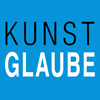

.jpg)
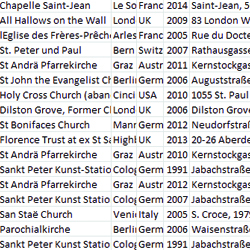


.jpg)
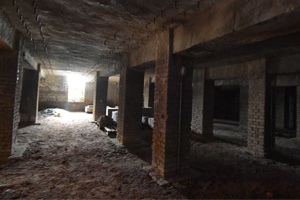
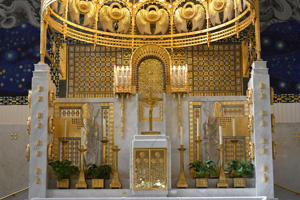
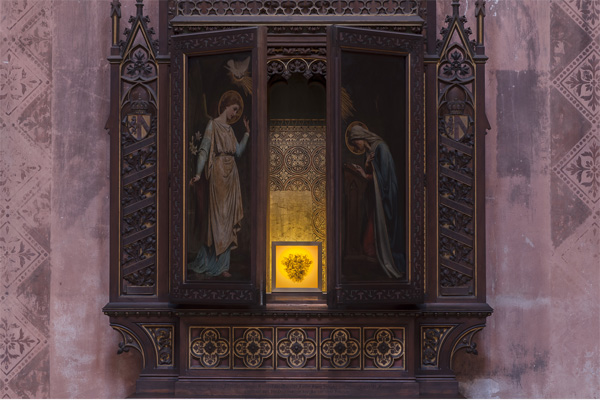

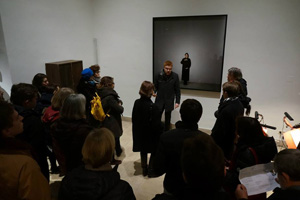

Christoph Bartylla-Print A4 360dpi.jpg)
Christoph Bartylla-Print A4 360dpi.jpg)
.jpg)
.jpg)

